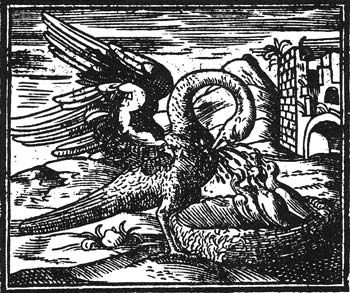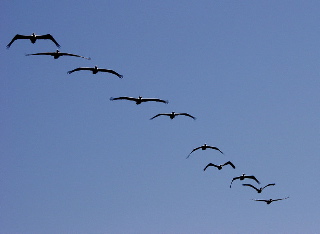Pelicanism 1897
Posted by: Loren Coleman on March 27th, 2008
Pelicans historically have held a bizarre place in animal folklore. The Physiologus says of the pelican that it of all birds loves its young the most.

The young pelicans in the Pieter van der Borcht (1545-1608) copperplate engraving (above) appear to be about to drink the blood of their mother; some versions of the story say that she feeds them her blood. The pose of the mother bird is known as “The Pelican in her Piety.”

Another illustration of this pelican tale is shown in a woodcut (above) from Rome, 1577.
“Pelicanism” is a term I wish to borrow from the Fortean field of ufology that comes into play in cryptozoology.
On page 35 from Jerome Clark’s book Strange Skies (2003), he elaborates on the concept of “pelicanism”:
Scottish debunker James Easton has argued that [Kenneth] Arnold’s objects [seen June 24, 1947] were merely pelicans — leading one wag to coin the term “pelicanist” to characterize one who proposes hard-to-believe solutions to puzzling UFO sightings.
There is reason to understand this also occurs within cryptozoology. “Pelicanists” have used nonexistent “escaped circus lions” to debunk local mystery cat sightings or unverified “out-of-place sandhill cranes” to explain away strange large bird reports.

Pelicans in flight, well, look like pelicans in flight.
The mundane has been used by “pelicanists” for a long time. Clark passes along an intriguing early literal use of the “pelican” explanation that overlaps with an old report of a flying unknown (the “Monster”), from the Weekly News and Courier of Charleston, South Carolina, June 30, 1897:
Was It A Flock of Pelicans?
A Very Plausible Solution of the Monster
Mystery of Stateburg and Darlington.
To the Editor of The News and Courier:
An air ship that could move as swiftly and pursue its course to its destination as directly as the object that was seen flying over Stateburg and Hartsville one Sunday evening three or four weeks ago would surely be a priceless treasure to any Government and a wonderful piece of mechanism to be manufactured by the inventive genius of man, and still more wonderful does it become, as a snake or an air ship, when the manner of its movement and progression is taken into consideration, all the laws of aerial or aquatic navigation having been set at defiance, in that the thing cuts through the air sideways instead of endways, at a speed exceeding that of the fastest railroad trains.
Hartsville on the map is in a direction northeast by north from Stateburg, and distant some forty miles or more on a bee line, and according to the several statements it must have been seen at the former place little, if any, more than half an hour after it had been observed flying over the latter, showing a speed of not less than eighty miles an hour. Migratory birds do not travel over long distances at this season of the year, and yet, without doubt, the object under discussion must have been a flock of sea fowl of some kind, changing their quarters from the Gulf of Mexico to the Atlantic coast.
Ducks usually fly abreast of each other, but ducks would have formed a thinner line than the one described. Sand hill cranes are hardly ever seen east of the Mississippi, and fly with outstretched necks and legs, which scarcely could have escaped notice when it was in the power of vision to detect the covering of feathers, besides in flocks their flight is like that of geese, in single file, one after another.
The pelican is a bird of very strong and rapid flight, its color is gray and it flies with neck doubled up and head tucked back between the shoulders, so that a flock of them flying abreast of each other would form a very compact linear figure, marked by more or less evenly defined outlines, and it is quite probable that the Stateburg and Hartsville stranger, which has caused so much speculation and wonder, was a gay party of pelicans on a “lark” from the torrid coasts of their own State to the more breezy locality of Hatteras or Albemarle sound.
Whether pelicans flying in numbers together go abreast or in single file is beyond the memory of your correspondent, but this point can, no doubt, be readily settled by any one of the pilots or fishermen of the City by the Sea. W. W. Anderson, Sr. Stateburg, S.C., June 21, 1897.
The flying “Monster” in South Carolina was all the talk of 1897 (see, for example, Clark’s Unnatural Phenomena, for a report of this “Sky Serpent” on page 295).
About Loren Coleman
Loren Coleman is one of the world’s leading cryptozoologists, some say “the” leading living cryptozoologist. Certainly, he is acknowledged as the current living American researcher and writer who has most popularized cryptozoology in the late 20th and early 21st centuries.
Starting his fieldwork and investigations in 1960, after traveling and trekking extensively in pursuit of cryptozoological mysteries, Coleman began writing to share his experiences in 1969. An honorary member of Ivan T. Sanderson’s Society for the Investigation of the Unexplained in the 1970s, Coleman has been bestowed with similar honorary memberships of the North Idaho College Cryptozoology Club in 1983, and in subsequent years, that of the British Columbia Scientific Cryptozoology Club, CryptoSafari International, and other international organizations. He was also a Life Member and Benefactor of the International Society of Cryptozoology (now-defunct).
Loren Coleman’s daily blog, as a member of the Cryptomundo Team, served as an ongoing avenue of communication for the ever-growing body of cryptozoo news from 2005 through 2013. He returned as an infrequent contributor beginning Halloween week of 2015.
Coleman is the founder in 2003, and current director of the International Cryptozoology Museum in Portland, Maine.










Those aren’t pelicans. They’re…they’re….ROPEN!!!!!!!
Couldn’t resist.
Did want to ask, though. Aren’t those pelican-feeding-young illustrations kinda missing, well, what makes a pelican a pelican…? Like, the beak that holds more than its belican?
Talk about pelicanism.
I’m sure most of us have seen pelicans flying in a row at some point in our lives. One interesting thing that may not be common knowledge is that white pelicans sometimes winter far inland, and are a common sight (to those who know what they are) in north Texas. A mysterious, large, white bird flying or floating might explain at least a few observations of cryptids and UFO-types, do you think?
ETxArtist:
As one who thinks the white pelican is probably America’s most easily identifiable bird in flight (bald eagle? Please….)
…I STILL think one could mistake one for a UFO. Like I almost did when I saw a pair of them over the Chesapeake and Delaware Canal a few Octobers back.
They were NOT SUPPOSED TO BE THERE.
(Although they not only winter, but summer far inland, for example, Grand Teton and Yellowstone NPs.)
So now? Well, of course, a small party of them has spent the past, say, three or so winters at Blackwater National Wildlife Refuge in Dorchester County, MD. Neither this nor the C&D is “far inland.” They are, however, far from where you should expect white pelicans. Ever.
That was then, I guess, and now is now. I just wish they’d prepared me better.
Birds, as Roger Tory Peterson once put it, have wings, and they do things.
well if ufology coined the term pelicanism for airbourne things
then i herby claim otterism for water bound cryptids on behalf of cryptomundo 😛
Fair enough, but don’t star-travelling aliens also qualify as a “hard-to believe solution” for puzzling UFO sightings?
“otterism”! LOL High five noobfun 😉
I agree with greatanarch- there undoubtedly are ‘pelicanists’, but i really strongly suspect the real problem in cryptozoology is the people doing the opposite (proposing incredible answers on the basis of insufficient/inconclusive evidence – ‘unicornists’ perhaps?)
things-in-the-woods:
You’re right. And as I’ve pointed out elsewhere on this site it’s sort of science’s fault. (Although I accept individuals’ protestations that their plates are full, and the nuttiness of some proponent theories makes the field, um, sorta risky.)
If mainstream scientists leave cryptozoology to amateurs, this is what happens.
—————————–
Question: So, sir, why do so few people see sasquatch, if they exist? Why is there so little evidence?
Amateur answers:
“Um, he’s a, um, shapeshifter.”
“Um, he’s a, um, time traveler from another world.”
“Um, the saucer people don’t want us to think he’s a regular thing, but in fact a warning…”
“There may be only five.”
“They bury their dead. I’ve seen it.”
“They orb to avoid notice.”
“They are NOT found in Iowa.” (Um, how do you KNOW, sir…?)
Professional answer:
“Actually, lots of people seem to see them. And there’s lots of supporting evidence. We have a head start on the biology of the species from the anecdotal evidence alone. And the data supports statistical investigation and biogeographical expectations. Problem is: if you see one of these, you’re a nut. Kinda makes funding a confirmation effort (not a search, note; people seem already to have found the sasquatch) difficult.”
———————————–
Against time-traveling shape-shifting orbing blobsquatch, all of a sudden
“inexplicable mass hallucination” or
“a continent of lying hoaxers working in league” or
“one or two incredible geniuses, wasting their time for peanuts when they could blaze new scientific trails – or make the biggest fortunes ever – with their smarts”
sound, well, almost rational.
Wait a second here.
If the complaint is against hard-to-believe solutions, let’s assume your choices are:
1. A sandhill crane, out of its normal range and not otherwise reported, with witnesses making some mistakes in describing it.
2. A flying vertebrate of sandhill crane size or larger, which has lived undiscovered in the United States until the present.
Which is harder to believe?